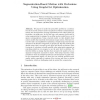Free Online Productivity Tools
i2Speak
i2Symbol
i2OCR
iTex2Img
iWeb2Print
iWeb2Shot
i2Type
iPdf2Split
iPdf2Merge
i2Bopomofo
i2Arabic
i2Style
i2Image
i2PDF
iLatex2Rtf
Sci2ools
DAGM
2006
Springer
2006
Springer
Segmentation-Based Motion with Occlusions Using Graph-Cut Optimization
Abstract. We propose to tackle the optical flow problem by a combination of two recent advances in the computation of dense correspondences, namely the incorporation of image segmentation and robust global optimization via graph-cuts. In the first step, each segment (extracted by colour segmentation) is assigned to an affine motion model from a set of sparse correspondences. Using a layered model, we then identify those motion models that represent the dominant image motion. This layer extraction task is accomplished by optimizing a simple energy function that operates in the domain of segments via graph-cuts. We then estimate the spatial extent that is covered by each layer and identify occlusions. Since treatment of occlusions is hardly possible when using entire segments as matching primitives, we propose to use the pixel level in addition. We therefore define an energy function that measures the quality of an assignment of segments and pixels to layers. This energy function is then...
Related Content
| Added | 22 Aug 2010 |
| Updated | 22 Aug 2010 |
| Type | Conference |
| Year | 2006 |
| Where | DAGM |
| Authors | Michael Bleyer, Christoph Rhemann, Margrit Gelautz |
Comments (0)

